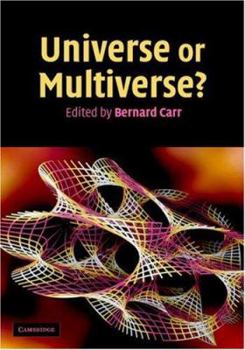Universe or Multiverse?
Select Format
Select Condition 
Book Overview
Recent developments in cosmology and particle physics, such as the string landscape picture, have led to the remarkable realization that our universe - rather than being unique - could be just one of... This description may be from another edition of this product.
Format:Hardcover
Language:English
ISBN:0521848415
ISBN13:9780521848411
Release Date:June 2007
Publisher:Cambridge University Press
Length:517 Pages
Weight:2.65 lbs.
Dimensions:1.1" x 7.1" x 9.7"
Customer Reviews
2 ratings
The state of knowledge as it stands now
Published by Thriftbooks.com User , 14 years ago
One answer to the question about us being the only intelligent life in the cosmos is answered by the multiverse theory of multiple universes. This is a subject that has received a lot of thinking and mathematical analysis in recent years. Recent developments in cosmology and particle physics, such as the string landscape picture, have led to some serious thinking that ours is not the only universe. This book has papers from a number of active and eminent researchers in the field, mainly from cosmologists and particle physicists, but also from such diverse fields as philosophy. The papers cover the complete spectrum from enthusiastic support to outright scepticism. There is very little advanced mathematics in the book when compared with some other texts on the subject.
An excellent book on a very interesting topic
Published by Thriftbooks.com User , 16 years ago
This is a wonderful and highly readable book about the question of whether or not our universe is part of a multiverse. The more than two dozen contributors all do a fine job. We see plenty about the Anthropic Principle and about the Copernican Principle (also known as the Principle of Mediocrity). The Anthropic Principle merely points out that given that we exist in this universe, our universe must be habitable. But this argument can be extended. Steven Weinberg shows how he was able to use the Principle of Mediocrity and the Anthropic Principle to put some interesting probable bounds on a cosmological constant. A universe with such a constant being less than 0.6 would be relatively unlikely for humans to be in, so his guess was that this constant was over 0.6. At the time, most guesses for the cosmological constant were 0.0, but soon after this, studies of supernovae showed that this constant is around 0.7. Several of the contributors discuss this argument. It's an unusual type of argument, and Weinberg makes an analogy to Einstein's use of a symmetry principle argument to come up with the Special Theory of Relativity (nowadays, symmetry principle arguments are commonplace, but Einstein's, in 1905, was the first major successful one). Several contributors also discuss Hoyle's use of the Anthropic Principle to claim that there must be an excited state of Carbon-12 with the right energy to produce carbon in stars. This excited state is no big surprise, given the general properties of alpha-particle couplings, so Weinberg and others are unimpressed. However, I side with Hoyle here. Weinberg explains that we now have a vast number of possible values of physical parameters provided by the "string landscape." By the Anthropic Principle, we can guess that we must be in a universe that permits us to exist. The reader is left to guess that therefore, there are probably many other universes where we can not and do not exist. Weinberg also points out that the Anthropic Principle shows how the universe can appear to be fine-tuned to allow our existence without requiring some sort of Intelligent Creator or Creators. Frank Wilcek shows how in the case of inflationary cosmology, we see that universal laws need not be multiversal. Stephen Hawking says that the reason we live in four dimensions (three of which are spatial) is not due to any anthropic principle (maybe there could be intelligent life in eleven dimensions) but simply because we can see that we live in four dimensions. He does, however, say that it may be significant that we live in the interior of anthropically allowed regions of omega-space. By not being at the edge of such a region, we wind up in a universe with many galaxies, not just one galaxy. That implies that variations in omega are fairly flat. One galaxy ought to suffice for life to exist, and since there are many, Hawking does not conclude that we need many galaxies, but that there are in fact many sites which cont




